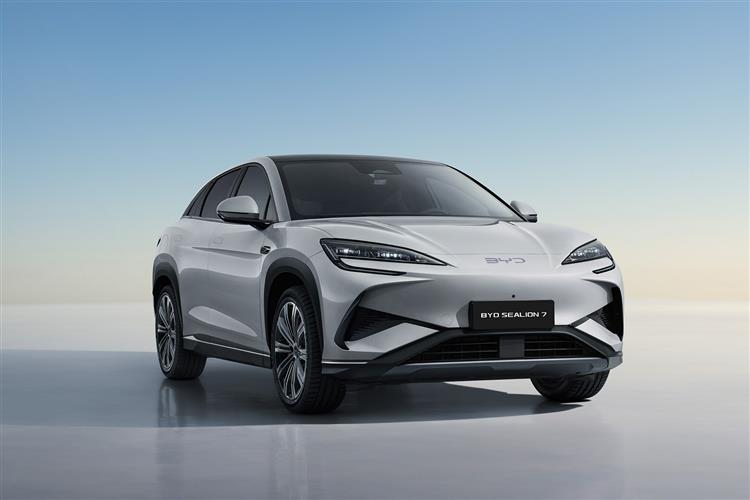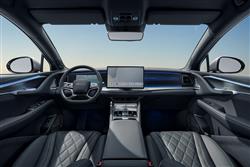SEALION PRESERVATION (some text hidden) --NONE--
By Jonathan Crouch
Cars like BYD's Sealion 7 will in future be European-built to preserve this Chinese maker's Western sales surge. Jonathan Crouch drives it.
Ten Second Reviewword count: 31
With this Sealion 7, BYD brings us its most sophisticated car yet, an upper mid-sized electric SUV with the engineering and luxury to take this Chinese maker firmly into premium territory.
Backgroundword count: 235
If the European makers thought that imposing stringent tariffs on the flood of Chinese-built EVs entering our market would stem the Oriental sales tide, they may need to think again. For the reasons as to why, let's take the car in front of us here as a case study, the BYD Sealion 7. This BYD flagship model, a sleekly-styled mid-sized electric SUV, will initially be hit with a costly EV tariffs, but from 2026 when the Chinese maker's new Hungarian factory comes on stream, it will by-pass those entirely. And it's at that stage that the competitors being targeted here - primarily Tesla, the Volkswagen Group and Stellantis - will really feel the force of BYD. Globally, they already have. In 2024, BYD sold 4.7 million new vehicles, a year after overtaking Tesla to become the world's largest electric vehicle maker, while also overtaking Volkswagen as China's best-selling automotive brand. This car introduces the brand's latest, rather different model structure that in future will see all the marque's SUVs bear 'Sealion' badges, all its saloons designated 'Seal' and all its hatchbacks have a 'Dolphin' nameplate, each model design with a number to indicate its positioning in the range. As for this Sealion 7, which reached the UK market in late 2024, well it aims to encapsulate everything BYD has so far learned as a car maker. Which as it turns out, is quite a lot.
Driving Experienceword count: 390
In this case, there are two kinds of Sealion; docile and fierce. The docile entry-level 'Comfort' version uses an 82.5kWh battery and is propelled by a 308bhp single rear motor, which BYD says can run at up to 23,000rpm, making it the world's fastest electric motor in mass production. Select the more urgent of the provided drive modes ('Sport') and the base variant makes 62mph in 6.7s en route to 113mph. Select 'ECO' and in theory the entry-level model can take the car up to 300 miles. The other drive settings are 'Normal' - and 'Snow' (which maximises traction in slippery conditions). Plus there are two regenerative braking modes, the strongest of which isn't that arresting. Fiercer Sealion variants use a dual motor powertrain, where the same rear motor is joined by a 215bhp front motor, creating a potent total output of 523bhp. This dual motor set-up can be had in the 'Design AWD' form we tried, with the 82.5kWh battery, which goes 283 miles on a charge. Or in top 'Excellence AWD' form with a larger 91.3kWh battery, which goes up to 312 miles on a charge. The dual motor versions have a '4.5 S' badge on the boot lid, which denotes the 0-62mph time. Top speed across the range is a most un-EV-like 133mph. So there's plenty of power, but then there needs to be to tug along a kerb weight that's anything between 2.2-tonnes and nearly 2.5-tonnes, depending on the number of motors your Sealion has. Can the chassis handle all this? Well on paper, you'd think the signs might be good. We liked the way that the Seal saloon handled and BYD claims the so-called 'e-Platform 3.0 EVO' underpinnings used here are even more rigid, aided as on all the brand's models by the way that the pioneering Cell-to-Body battery installation integrates the Blade Battery into the entire vehicle structure. Somewhere along the way though, some of the handling sharpness we liked in the Seal has been lost. Mindful perhaps that the Sealion would be heavier than the Seal, BYD has softened the suspension set-up - double wishbones at the front and a multi-link rear axle. But rather too much, with the result that the car pitches about at speed through fast corners in a manner that will discourage you from wanting to throw it about
To see the full road test text contact us on 0330 0020 227
Pictures (high res disabled)

.jpg)
|
.jpg)
|
.jpg)
| |||
.jpg)
|
.jpg)
|
.jpg)
| |||
.jpg)
|
.jpg)
|
.jpg)
| |||
.jpg)
|
.jpg)
|

|
Statistics (subset of data only)
Min |
Max |
|
Price: |
£47,000.00 (At 14 May 2025, Comfort - est) |
£59,000.00 (At 14 May 2025, Excellence AWD - est) |
Max Speed (mph): |
113 (Comfort) |
133 (Excellence AWD) |
0-62 mph (s): |
6.7 (Comfort) |
4.5 (Excellence AWD) |
Electric WLTP-Rated Driving Range (miles): |
283 |
|
Length (mm): |
4830 |
|
Width (mm): |
1925 |
|
Height (mm): |
1620 |
|
Boot Capacity (l): |
520 |
|
Power (ps): |
308 (Comfort) |
523 (Excellence AWD) |
Scoring (subset of scores)
Category: Hybrid, Plug-in, Electric & Hydrogen
| Performance | |
| Handling | |
| Comfort | |
| Space | |
| Styling, Build, Value, Equipment, Depreciation, Handling, Insurance and Total scores are available with our full data feed. | |



